Scythe Mugen 3 Processor Cooler Review

Let’s take a closer look at the third incarnation of the world’s famous air-cooler from the Japanese Scythe Company.
Two and a half years ago when we prepared our review of the then new Scythe Mugen 2 cooler, I confidently names the Japanese Scythe Co., Ltd. the leader among manufacturers of processor air-cooling products. And I had every legitimate right to say so. Today things have changed. Strange as it might seem, but Scythe is the one to blame for the changes, because they currently have no coolers that could successfully compete against the today’s best solutions, like NZXT Havik 140 or Thermalright Archon. As for the mainstream price segment, where the competition is particularly cut-throat these days, Scythe also can’t offer a definite winning product – it turns out way harder to withstand the attacks of the inexpensive Zalman CNPS10X Performa or Thermalright True Spirit than to design an ultimately most efficient air-cooler. The new, third, incarnation of the popular Scythe Mugen cooler is destined to change the course of things. Let’s find out from our new review if it succeeds or not.
Packaging and Accessories
Scythe continues to maintain the same approach to designing their cooler packaging. The products are still shipped in vertical boxes covered with tons of information:
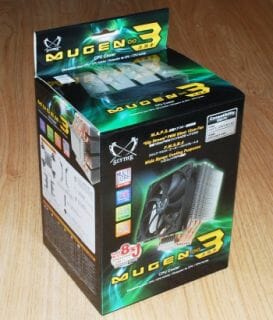
There is hardly any free room on the thick black cardboard of the box:
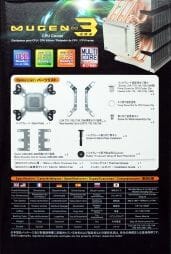
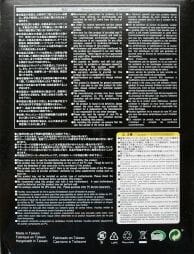
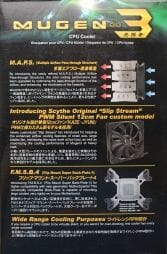
Inside there is a smaller box with a backplate, two pairs of steel retention brackets, thermal paste, retention screws and pads, installation guide and two wire clips for attaching the fan to the heatsink:
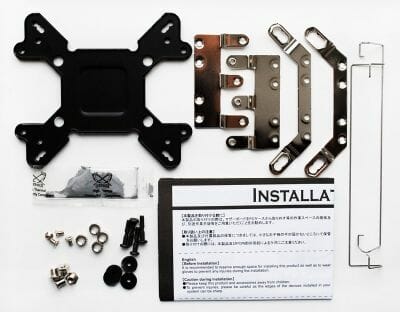
Mugen 3 is manufactured in Taiwan and is officially priced at $45.50. In retail the new cooler is currently selling for $49.90. I would also like to add that it comes with a 2-year warranty.
Design and Functionality
The design of the new Mugen 3 cooler looks dramatically different, although you can still find certain resemblance with the previous, Mugen 2, model. The newcomer measures 158x130x108 mm and weighs 835 grams. Let’s take a closer look at it.
The cooler heatsink is still designed with M.A.P.S. (Multiple Airflow Pass-Through Structure) technology in mind, but unlike Mugen 2 it has fewer (four) heatsink arrays instead of five and more (six) heatpipes instead of five.
The copper heatpipes are of the same diameter as before – 6 mm. Each heatsink array consists of 48 aluminum plates, 0.35 mm thick. They are pressed against the heatpipes at 1.8 mm distance from one another.
Each heatsink array is pierced with three copper heatpipes. These heatpipes alternate in the base of the cooler and get evenly distributed across the heatsink arrays.
This ensures that the heat is distributed evenly over the heatsink fins and that the heat transfer is performed in an efficient manner. At the same time I can’t help mentioning that compared with Mugen 2, the new cooler has about 2700 cm2 smaller effective heatsink surface, which equals only 7,920 cm2.
There is an additional aluminum heatsink right above the cooler base. It is 42x52x18 mm big and is designed to remove the heat from the upper part of the heatpipes. The base itself is extremely even and is perfectly finished.
Note that while the heatsink fins are simply pressed against the heatpipes, Scythe used soldering for the base of the cooler. Here the heatpipes lie in specially made grooves with no more than 1.5 mm gaps between one another, and the thinnest part of the copper nickel-plated base beneath the heatpipes is 5 mm.
The thermal paste imprint left by the cooler base on the processor heat-spreader is not totally perfect, because our LGA1366 processor has a slightly uneven surface.
Mugen 3 heatsink is equipped with a nine-blade Scythe Slip Stream 120 fan measuring 120x120x25 mm.
The fan model is SY1225SL12M-P supports PWM rotation speed control and spins at 300-1600 RPM creating 14.7-88.11 CFM airflow. It generates between 9.6 and 32.15 dBA of noise.
The slide bearing should last at least 30,000 hours or 3.4 years if used continuously without stopping. The fan’s maximum power consumption shouldn’t exceed 4.6 W, but it turned out 3.8 W, according to our measurements. The fan startup voltage is 3.8 V.
The fan is attached to the heatsink with two wire clips, which ends should be inserted into special retention holes.
There are no shock-absorbing pads of any kind bundled with the cooler. I think they could have also included an extra pair of wire clips in case someone decides to use a second fan and the heatsink actually allows it. Moreover, Scythe also offers a special Mugen 3 revision called “PC Games Hardware Edition”, which comes bundled with two quiet Scythe Slip Stream 120 fans. Therefore, it is totally unclear why they couldn’t just throw in another pair of wire clips?
Compatibility and Installation
Scythe Mugen 3 is compatible with all contemporary platforms. Unfortunately, the Japanese cooler maker hasn’t yet started to bundle their products with the new LGA2011 retention kits, although I think it is about time. The installation procedure isn’t any different from that used for Mine 2, but this time they use a new, fourth backplate modifications – F.M.S.B.4 (Flip Mount Super Back-Plate 4).
The backplate has become smaller in size, but remained fully universal and at the same time is now even more compatible with contemporary mainboards.
The cooler is fastened with screws, which should be inserted from the bottom of the PCB into the screw-nuts attached to the ends of the retention brackets.
The retention provides super-strong hold, but it is not too strong for the board to start bending under pressure. The distance between the lowest heatsink fin and the mainboard surface is 48 mm. Keeping in mind that in both cooler positions the heatsink with the attached fan will block at least the one DIMM slot closest to the processor, this space may be insufficient to ensure conflict-free coexistence of the Mugen 3 cooler and memory modules with tall heat-spreaders.
The cooling efficiency of Scythe Mugen 3 doesn’t depend on the way it is installed on the CPU and positioned inside the system case. And this is true for both configurations: with a single default fan as well as two alternative fans at different rotation speeds.
The difference in processor peak temperature between these two installations never exceeded 1 degree C that is why we decided to use only one configuration during the main part of our test session, namely when the airflow is directed towards the back of the system case.
Testbed and Testing Methodology
We performed all cooler tests inside a closed system case. Here is our testbed configuration:
- Mainboard: Gigabyte GA-X58A-OC (Intel X58 Express, LGA 1366, BIOS F5c from 09/06/2011);
- Processor: Intel Core i7-980X Extreme Edition, 3.33 GHz, 1.225 V, 6 x 256 KB L2, 12 MB L3 (Gulftown, B1);
- Thermal interface: Arctic MX-2;
- Graphics card: ATI Radeon HD 5770 1 GB GDDR5 128 bit, 850/4800 MHz (with a passive heatsink from the DeepCool V4000 VGA cooler);
- Memory: DDR3 3 x 2 GB OCZ Platinum Low-Voltage Triple Channel (Spec: 1600MHz / 7-7-7-24 / 1.65 V);
- System drive: RAID-0 of 2 x Kingston V-series SNV425S2128GB SSD (SATA-II, 128 GB, MLC, Toshiba TC58NCF618G3T controller);
- Drive for programs and games: Western Digital VelociRaptor (300GB, SATA-II, 10000 RPM, 16MB cache, NCQ) inside Scythe Quiet Drive 3.5” HDD silencer and cooler;
- Backup drive: Samsung Ecogreen F4 HD204UI (SATA-II, 2 TB, 5400 RPM, 32 MB, NCQ);
- System case: Antec Twelve Hundred (front panel: three Noiseblocker NB-Multiframe S-Series MF12-S2 fans at 1020 RPM; back panel: two Noiseblocker NB-BlackSilent PRO PL-1 fans at 1020 RPM; top panel: standard 200 mm fan at 400 RPM);
- Control and monitoring panel: Zalman ZM-MFC2;
- Power supply: Xigmatek “No Rules Power” NRP-HC1501 1500 W (with a default 140 mm fan).
We overclocked our six-core processor (with its default non-lapped heat-spreader) with the multiplier set at 25x and “Load-Line Calibration” (Level 2) enabled to 4.3 GHz. The nominal processor Vcore was increased to 1.3875 V in the mainboard BIOS.
Turbo Boost and Hyper-Threading technologies were disabled during our test session. The memory voltage was at 1.5 V and its frequency was 1.38 GHz with 7-7-7-16_1T timings (Extreme profile). All other parameters available in the mainboard BIOS and related to CPU or memory overclocking remained unchanged.
All tests were performed under Windows 7 Ultimate x64 SP1 operating system. We used the following software during our test session:
- CPU Stress Test (CST) version 0.18b – to load the processor (matrix # 15, 10-12 minutes);
- Real Temp GT 3.64 – to monitor the processor core temperature;
- CPU-Tweaker 1.5 – to visually monitor temperatures and frequencies using graphics;
- Gigabyte Easy Tune 6 B11.0823.1 – to monitor voltages.
So, the complete screenshot during the test session looks as follows.
The CPU was loaded with two consecutive CST test runs with the settings as indicated above. The stabilization period for the CPU temperature between the two test cycles was about 8-10 minutes. We took the maximum temperature of the hottest CPU core for the results charts. Moreover, we will also provide a table with the temperature readings for all cores including their average values. The ambient temperature was checked next to the system case with an electronic thermometer with 0.1 °C precision that allows hourly monitoring of the temperature changes over the past 6 hours. The room temperature during our test session varied between 20.0-20.4 °C.
The noise level of each cooler was measured between 1:00 and 3:00 AM in a closed room about 20 m2 big using CENTER-321 electronic noise meter. The noise level for each cooler was tested outside the system case when the only noise sources in the lab were the cooler and its fan. The noise meter was installed on a tripod and was always at a 150 mm distance from the cooler fan rotor. The tested cooling systems were placed at the edge of the desk on a sheet of polyurethane foam. The lowest noise reading our noise meter device can register is 29.8 dBA and the subjectively comfortable noise level in these testing conditions was around 36 dBA (do not mix it up with low noise level). The fan(s) rotation speed was adjusted in the entire supported range using our in-house controller by changing the voltage with 0.5 V increment.
We are going to compare Scythe Mugen 3 against Thermalright True Spirit cooler ($30). Besides the default fan, the latter cooler was also tested with two Thermalright TR-FDB fans. Mugen 3 was also tested with these two fans, besides its default Scythe Slip Stream 120. We are going to use the results of Thermalright Archon tested with one and two Thermalright TY-140 fans as our reference point.
Now let’s check out the obtained results.
Performance
Cooling Efficiency Tests
With only one default cooling fan the new Scythe cooler turned out as efficient as Thermalright True Spirit. Under peak load it yielded only 1°C at 1200 and 1400 RPM, while at lower fan speeds both these coolers proved equally efficient. The situation is the same in those test modes where we used alternative Thermalright fans. Unfortunately, for Mugen 3, it and True Spirit demonstrated identical efficiency. I said “unfortunately”, because True Spirit cooler is currently retailing for at least $15 less than Mugen 3 ($29.95 vs. $45.5), therefore, the choice in this case will be obvious. Besides, I also have to point out that the cooling efficiency of Mugen 3 doesn’t change too much when we add a second fan for air exhaust. M.A.P.S. technology does work well and indeed makes the cooler as independent of the number of fans and their rotation speed as possible.
During the maximum overclocking tests with Scythe Mugen 3 we discovered that our cooler can easily cope with a 6-core processor overclocked to 4450 MHz at 1.4625 V core voltage with only one default Scythe Slip Stream 120 fan rotating at 1550 RPM. The temperature of the hottest processor core in this case was 91°C.
When we tested Mugen 3 with two Thermalright TR-FDB fans at their maximum rotation speed of 2040 RPM, we could push our overclocking success even higher: 4475 MHz at 1.46875 V Vcore and 89°C maximum temperature. These are very good results, if we do not take the noise into consideration at this point.
Now it is time to add the results of maximum CPU overclocking to our summary table for all tested cooling solutions. Besides the processor frequency, it also shows maximum temperature (again taking into account the difference in the ambient temperature) and the level of generated noise. Unlike the previous summary diagram, here all participants were tested in their default configurations (i.e. without any additional/replacement fans).
Scythe Mugen 3 maintains steady position in the very center of the pack. Its closest rivals are Thermalright HR-02 Macho (a little more efficient and much quieter) and Thermalright True Spirit (a little less efficient and noisy).
Acoustic Performance
We measured the acoustic performance of our today’s testing participants in the entire rotation speed range of their fans. The results are summed up on the following graph.
As we see, there is very little difference in the level of noise between the three cooling systems compared in this test session. However, I am sure that our regular readers aren’t surprised with these results, because we have already tested their fans (Scythe Slip Stream 120, Thermalright X-Silent and Thermalright TY-140) in our fan roundups.
Conclusion
Scythe Mugen 3 turned out a good mainstream cooler that doesn’t break any records. We didn’t have the opportunity to compare it against the previous Mugen 2 model anymore, but we are practically certain that the new products didn’t really outdo the predecessor and simply joined the ranks of efficient processor coolers. Although it has more heatpipes than Mugen 2, boasts enhanced M.A.P.S. technology, has special grooves for heatpipes in the base plate, it features a heatsink of very modest effective size and therefore can’t shoot for the super-cooler title.
Nevertheless, Scythe Mugen 3 can easily cope with cooling pretty seriously overclocked multi-core processors and will do so without much noise. Universal design, reliable retention, a PWM controlled fan and two-year warranty should make Scythe Mugen 3 a very attractive offering at the MSRP of $45.50. However at the same time, the new Japanese cooler, just like many other coolers out there, will have hard time competing against Thermalright True Spirit.